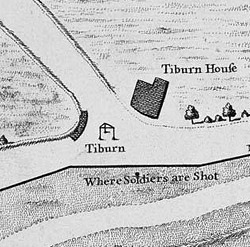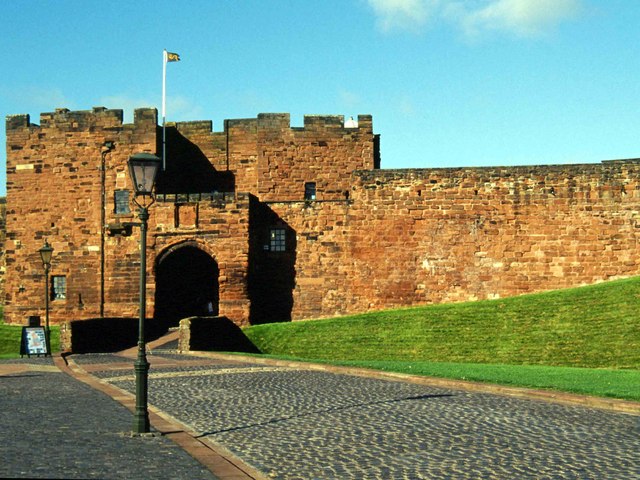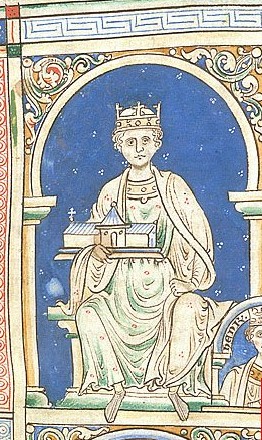|
Francis Bigod
Sir Francis Bigod (4 October 1507 – 2 June 1537) was an English nobleman who was the leader of Bigod's Rebellion. Family Francis Bigod was descended from the Bigod Earls of Norfolk and from the Barons Mauley of Mulgrave Castle near Whitby, Yorkshire. Born 4 October 1507 at Seaton Manor in Hinderwell, Yorkshire, Francis was the eldest son of Sir John Bigod and Joan Strangways, the daughter of Sir James Strangways. His father was killed by the Scots in 1513, perhaps at the Battle of Flodden. His paternal grandfather, Sir Ralph Bigod, died two years later in 1515, leaving Francis, then seven years of age, as his heir. After the death of Francis' father, his mother, Joan, married Sir William Maleverer. Career On 9 May 1515, Francis' wardship was granted to Cardinal Thomas Wolsey, and he may have grown up in Wolsey's household. He attended Oxford, but left without taking a degree, though his letters show that he was a scholar. In 1527, he was in Wolsey's service. He proved h ... [...More Info...] [...Related Items...] OR: [Wikipedia] [Google] [Baidu] |
Pilgrimage Of Grace
The Pilgrimage of Grace was a popular revolt beginning in Yorkshire in October 1536, before spreading to other parts of Northern England including Cumberland, Northumberland, and north Lancashire, under the leadership of Robert Aske. The "most serious of all Tudor period rebellions", it was a protest against Henry VIII's break with the Catholic Church, the dissolution of the lesser monasteries, and the policies of the King's chief minister, Thomas Cromwell, as well as other specific political, social, and economic grievances. Following the suppression of the short-lived Lincolnshire Rising of 1536, the traditional historical view portrays the Pilgrimage as "a spontaneous mass protest of the conservative elements in the North of England angry with the religious upheavals instigated by King Henry VIII". Historians have observed that there were contributing economic factors. Prelude to revolt The 16th century During the Tudor era there was a general rise in the population a ... [...More Info...] [...Related Items...] OR: [Wikipedia] [Google] [Baidu] |
Greyfriars, London
In London, the Greyfriars was a Conventual Franciscan friary that existed from 1225 to 1538 on a site at the North-West of the City of London by Newgate in the parish of St Nicholas in the Shambles. It was the second Franciscan religious house to be founded in the country. The establishment included a conventual church that was one of the largest in London; a '' studium'' or regional university; and an extensive library of logical and theological texts. It was an important intellectual centre in the early fourteenth century, rivalled only by Oxford University in status. Members of the community at that time included William of Ockham, Walter Chatton and Adam Wodeham. It flourished in the fourteenth and fifteenth century but was dissolved in 1538 at the instigation of Henry VIII as part of the Dissolution of the Monasteries. Christ's Hospital was founded in the old conventual buildings, and the church was rebuilt completely by Sir Christopher Wren as Christ Church Greyfriar ... [...More Info...] [...Related Items...] OR: [Wikipedia] [Google] [Baidu] |
Tyburn
Tyburn was a manor (estate) in the county of Middlesex, one of two which were served by the parish of Marylebone. The parish, probably therefore also the manor, was bounded by Roman roads to the west (modern Edgware Road) and south (modern Oxford Street), the junction of these was the site of the famous Tyburn Gallows (known colloquially as the "Tyburn Tree"), now occupied by Marble Arch. For this reason, for many centuries, the name Tyburn was synonymous with capital punishment, it having been the principal place for execution of London criminals and convicted traitors, including many religious martyrs. It was also known as 'God's Tribunal', in the 18th century. Tyburn took its name from the Tyburn Brook, a tributary of the River Westbourne. The name Tyburn, from Teo Bourne, means 'boundary stream',Gover, J. E. B., Allen Mawer and F. M. Stenton ''The Place-Names of Middlesex''. Nottingham: English Place-Name Society, The, 1942: 6. but Tyburn Brook should not be confused wit ... [...More Info...] [...Related Items...] OR: [Wikipedia] [Google] [Baidu] |
Carlisle Castle
Carlisle Castle is a medieval stone keep castle that stands within the English city of Carlisle near the ruins of Hadrian's Wall. First built during the reign of William II in 1093 and rebuilt in stone under Henry I in 1122, the castle is over 900 years old and has been the scene of many historical episodes in British history. Given the proximity of Carlisle to the border between England and Scotland, it has been the centre of many wars and invasions. During the Jacobite Rising of 1745–6, Carlisle became the last English fortress to undergo a siege. The castle was listed as a Scheduled Ancient Monument on 7 August 1996. Today the property is managed by English Heritage and is open to the public. Until 2006, the castle was the administrative headquarters of the former King's Own Royal Border Regiment and until 2019 it was the county headquarters to the Duke of Lancaster's Regiment. A museum to the regiment is within the castle walls. History Carlisle Castle was first bu ... [...More Info...] [...Related Items...] OR: [Wikipedia] [Google] [Baidu] |
Cumberland
Cumberland ( ) is a historic county in the far North West England. It covers part of the Lake District as well as the north Pennines and Solway Firth coast. Cumberland had an administrative function from the 12th century until 1974. From 1974 until 2023, Cumberland lay within Cumbria, a larger administrative area which also covered Westmorland and parts of Yorkshire and Lancashire. In April 2023, Cumberland will be revived as an administrative entity when Cumbria County Council is abolished and replaced by two unitary authorities; one of these is to be named Cumberland and will include most of the historic county, with the exception of Penrith and the surrounding area. Cumberland is bordered by the historic counties of Northumberland to the north-east, County Durham to the east, Westmorland to the south-east, Lancashire to the south, and the Scottish counties of Dumfriesshire and Roxburghshire to the north. Early history In the Early Middle Ages, Cumbria was part of t ... [...More Info...] [...Related Items...] OR: [Wikipedia] [Google] [Baidu] |
Beverley, Yorkshire
Beverley is a market and minster town and a civil parish in the East Riding of Yorkshire, England, of which it is the county town. The town centre is located south-east of York's centre and north-west of City of Hull. The town is known for Beverley Minster, Beverley Westwood, North Bar (a 15th-century gate) and Beverley Racecourse. It inspired the naming of the city of Beverly, Massachusetts, which in turn was the impetus for Beverly Hills, California.Marc Wanamaker, ''Early Beverly Hills'', Mount Pleasant, South Carolina: Arcadia Publishing, 2005, pp. 17–1/ref> The town was listed in the 2018 ''Sunday Times'' report on Best Places to Live in northern England. The town was originally known as ''Inderawuda'' and was founded around 700 AD by Saint John of Beverley during the time of the Anglian kingdom of Northumbria. After a period of Viking control, it passed to the Cerdic dynasty, a period during which it gained prominence in terms of religious importance in Gr ... [...More Info...] [...Related Items...] OR: [Wikipedia] [Google] [Baidu] |
Kingston Upon Hull
Kingston upon Hull, usually abbreviated to Hull, is a port city and unitary authority in the East Riding of Yorkshire, England. It lies upon the River Hull at its confluence with the Humber Estuary, inland from the North Sea and south-east of York, the historic county town. With a population of (), it is the fourth-largest city in the Yorkshire and the Humber region after Leeds, Sheffield and Bradford. The town of Wyke on Hull was founded late in the 12th century by the monks of Meaux Abbey as a port from which to export their wool. Renamed ''Kings-town upon Hull'' in 1299, Hull had been a market town, military supply port, trading centre, fishing and whaling centre and industrial metropolis. Hull was an early theatre of battle in the English Civil Wars. Its 18th-century Member of Parliament, William Wilberforce, took a prominent part in the abolition of the slave trade in Britain. More than 95% of the city was damaged or destroyed in the blitz and suffered a perio ... [...More Info...] [...Related Items...] OR: [Wikipedia] [Google] [Baidu] |
Hallam Hall
Hallam may refer to: Places * Hallam, Victoria, Australia ** Hallam railway station UK * Hallamshire, an area in South Yorkshire, England, UK ** Royal Hallamshire Hospital ** Sheffield Hallam (UK Parliament constituency) ** Sheffield Hallam University ** Hallam Tower, a high rise building in the Fulwood area of Sheffield ** Roman Catholic Diocese of Hallam * West Hallam in Derbyshire, England, UK ** West Hallam railway station * Hallam Street, Marylebone, London, England, UK USA * Hallam, Nebraska, United States ** Hallam Nuclear Power Facility, a nuclear reactor * Hallam, Pennsylvania, United States Other uses *Hallam (surname) * Reuben Hallam, author, who wrote in the Sheffield dialect * Hallam F.C. - a non-league football club in Sheffield * Hallam FM Hallam FM is an Independent Local Radio station based in Sheffield, England, owned and operated by Bauer as part of the Hits Radio network. It broadcasts to South Yorkshire. As of September 2022, the station has a weekly a ... [...More Info...] [...Related Items...] OR: [Wikipedia] [Google] [Baidu] |
Scarborough Castle
Scarborough Castle is a former medieval Royal fortress situated on a rocky promontory overlooking the North Sea and Scarborough, North Yorkshire, England. The site of the castle, encompassing the Iron Age settlement, Roman signal station, an Anglo-Scandinavian settlement and chapel, the 12th-century enclosure castle and 18th-century battery, is a scheduled monument of national importance. Fortifications for a wooden castle were built in the 1130s, but the present stone castle dates from the 1150s. Over the centuries, several other structures were added, with medieval monarchs investing heavily in what was then an important fortress that guarded the Yorkshire coastline, Scarborough's port trade, and the north of England from Scottish or continental invasion. It was fortified and defended during various civil wars, sieges and conflicts, as kings fought with rival barons, faced rebellion and clashed with republican forces, though peace with Scotland and the conclusion of civil and ... [...More Info...] [...Related Items...] OR: [Wikipedia] [Google] [Baidu] |
John Lumley, 1st Baron Lumley
John Lumley, 1st Baron Lumley, KB (c. 1533 – 1609) was an English aristocrat, who is remembered as one of the greatest collectors of art and books of his age. Early life John Lumley, born about 1533, was the grandson and heir of John, Lord Lumley. He was the only son of George Lumley (who had been executed in the lifetime of his father for his role in the Pilgrimage of Grace), by Jane, second daughter and coheir of Sir Richard Knightley of Upton, Northamptonshire. In a petition to Edward VI Lumley stated that he was a child at the death of his grandfather in 1544, to whose honours he did not succeed because of his own father's attainder, and in 1547 he obtained an Act of Parliament restoring him in blood, and enacting "that he, the said John Lumley and the heirs male of his body, should have hold, enjoy and bear the name, dignity, state and pre-eminence of a Baron of the Realm" whereby he became Baron Lumley (a new Barony being created of that name, in tail male ) and ... [...More Info...] [...Related Items...] OR: [Wikipedia] [Google] [Baidu] |
Watton, East Riding Of Yorkshire
Watton is a village and civil parish in the East Riding of Yorkshire, England. The village is situated on the A164 road, about north of Beverley and south of Driffield. According to the 2011 UK census the civil parish of Watton had a population of 259, an increase on the 2001 UK census figure of 238. History In the 6th century Watton was home to a Frankish saint, Monegunda of Watton and in the 13th century to William de Malton, master-mason who built Beverley Minster was buried here. The Venerable Bede in his ''Ecclesiastical History of the English People'' tells of a miracle of Saint John of Beverley that took place in Watton. It is also the setting for the 12th-century miracle story De Sanctimoniali de Wattun. Watton is the location for Watton Priory which was a Gilbertine double monastery founded in 1150 by Eustace fitz John. The present building dates mainly from the 14th and 15th centuries, although it has earlier origins, and a house was added in the ... [...More Info...] [...Related Items...] OR: [Wikipedia] [Google] [Baidu] |







